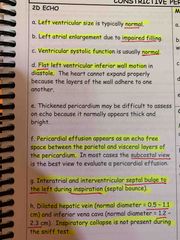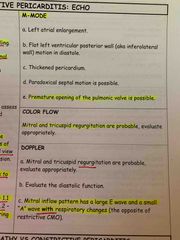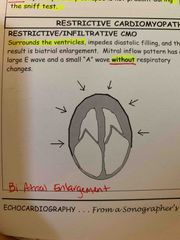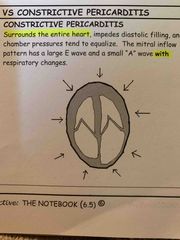![]()
![]()
![]()
Use LEFT and RIGHT arrow keys to navigate between flashcards;
Use UP and DOWN arrow keys to flip the card;
H to show hint;
A reads text to speech;
18 Cards in this Set
- Front
- Back
|
Pericarditis is an inflammatory or infectious process of the _____and _____ layers of the pericardium. The most common cause is____. Pericarditis may occur as an isolated diagnosis or in combination with another process; it can be local or general, acute or chronic |
Parietal Visceral Idiopathic |
|
|
Etiology of pericarditis are: acute injury occurs, fibrin, white blood cells, endothelial cells are released and cover the parietal and visceral layers of the pericardium, the fibrin is an insoluble protein |
Friction between the layers causes irritation and inflammation |
|
|
Two types of pericarditis are classified as _____ or______ |
Acute Chronic |
|
|
Acute onset occurs within _____ weeks of the offending condition. It can last up to ____ weeks. |
2 weeks 6 weeks |
|
|
Acute pericarditis may be dry and fibrinous creating a painful friction rub. This obstructs the venous system and lymphatic systems from draining properly and it seeps into pericardial sac causing effusion. This can relieve some of the pain. |
Fluid is typically clear, straw or amber, it's common to see blood or fibrous stands within effusion. |
|
|
Pericardial effusion is usually > ____ml of fluid. Normal pericardial sac contains 10-30ml of clear serous fluid. |
100ml |
|
|
_____ of accumulation is the key factor in how the heart compensates for extra fluid. |
Rate |
|
|
Chronic pericarditis onset follows acute pericarditis. T/F? |
True |
|
|
Chronic pericarditis can last up to ____ months |
6 |
|
|
Complications from pericarditis include ______, ________ _______. |
Pericardial effusion Tamponade Constrictive pericarditis |
|
|
A pericardial thickening and scarring of the parietal and/or visceral pericardium is called____. The layers become dense and adhere to one another, obliterating the pericardial space. Calcification may occur. |
Constrictive pericarditis |
|
|
With constructive pericarditis the heart eventually becomes a totally noncompliant structure restricting ______ filling. |
Diastolic |
|
|
Does the cardiac output increase/decrease from constrictive pericarditis? |
Decrease |
|
|
What chambers does the constrictive pericarditis affect? |
Usually all 4 chambers, however it can be local. |
|
|
If all for chambers are involved EQUALLY, the _____ _______ pressures within the right atrium, right ventricle, pulmonary artery, pulmonary capillary wedge and left ventricle will equalize and elevate. This equalization is detected by catheterization. |
End diastolic |
|
|
Treatment for pericardial constriction is _______. |
Pericardiectomy |
|

Constrictive pericarditis in 2D echo page 256 |

M-mode with constrictive Color flow and Doppler with constrictive pericarditis |
|

Restrictive/infiltrative CMO |

Constrictive pericarditis Pressure in chambers equalize E/a respiratory changes |

